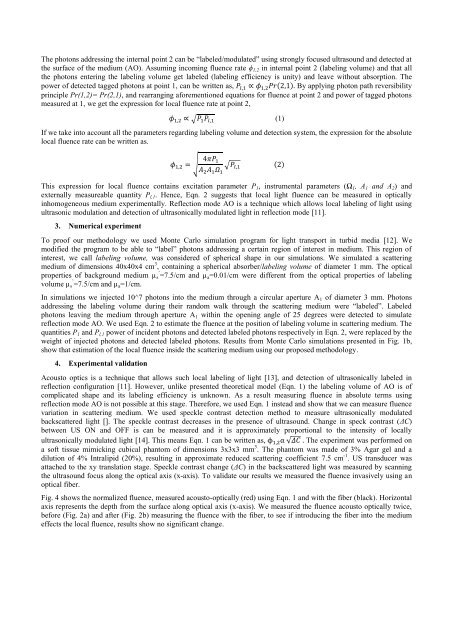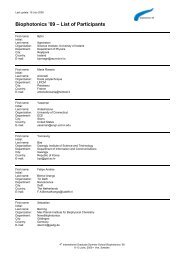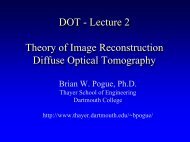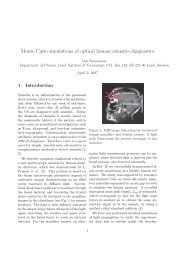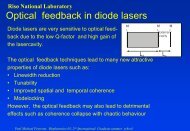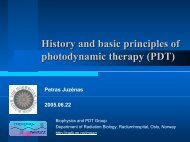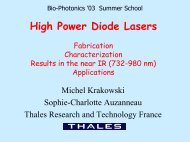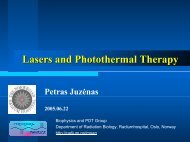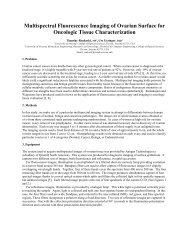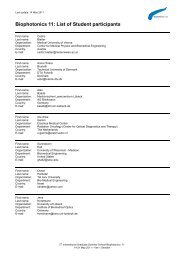Fluence mapping inside the highly scattering medium using ...
Fluence mapping inside the highly scattering medium using ...
Fluence mapping inside the highly scattering medium using ...
You also want an ePaper? Increase the reach of your titles
YUMPU automatically turns print PDFs into web optimized ePapers that Google loves.
The photons addressing <strong>the</strong> internal point 2 can be “labeled/modulated” <strong>using</strong> strongly focused ultrasound and detected at<br />
<strong>the</strong> surface of <strong>the</strong> <strong>medium</strong> (AO). Assuming incoming fluence rate ϕ1,2 in internal point 2 (labeling volume) and that all<br />
<strong>the</strong> photons entering <strong>the</strong> labeling volume get labeled (labeling efficiency is unity) and leave without absorption. The<br />
power of detected tagged photons at point 1, can be written as, ( ) By applying photon path reversibility<br />
principle Pr(1,2)= Pr(2,1), and rearranging aforementioned equations for fluence at point 2 and power of tagged photons<br />
measured at 1, we get <strong>the</strong> expression for local fluence rate at point 2,<br />
√ (1)<br />
If we take into account all <strong>the</strong> parameters regarding labeling volume and detection system, <strong>the</strong> expression for <strong>the</strong> absolute<br />
local fluence rate can be written as.<br />
√<br />
√ ( )<br />
This expression for local fluence contains excitation parameter P1, instrumental parameters (Ω1, A1 and A2) and<br />
externally measureable quantity Pl,1. Hence, Eqn. 2 suggests that local light fluence can be measured in optically<br />
inhomogeneous <strong>medium</strong> experimentally. Reflection mode AO is a technique which allows local labeling of light <strong>using</strong><br />
ultrasonic modulation and detection of ultrasonically modulated light in reflection mode [11].<br />
3. Numerical experiment<br />
To proof our methodology we used Monte Carlo simulation program for light transport in turbid media [12]. We<br />
modified <strong>the</strong> program to be able to “label” photons addressing a certain region of interest in <strong>medium</strong>. This region of<br />
interest, we call labeling volume, was considered of spherical shape in our simulations. We simulated a <strong>scattering</strong><br />
<strong>medium</strong> of dimensions 40x40x4 cm 3 , containing a spherical absorber/labeling volume of diameter 1 mm. The optical<br />
properties of background <strong>medium</strong> µs ’ =7.5/cm and µa=0.01/cm were different from <strong>the</strong> optical properties of labeling<br />
volume µs ’ =7.5/cm and µa=1/cm.<br />
In simulations we injected 10^7 photons into <strong>the</strong> <strong>medium</strong> through a circular aperture A1 of diameter 3 mm. Photons<br />
addressing <strong>the</strong> labeling volume during <strong>the</strong>ir random walk through <strong>the</strong> <strong>scattering</strong> <strong>medium</strong> were “labeled”. Labeled<br />
photons leaving <strong>the</strong> <strong>medium</strong> through aperture A1 within <strong>the</strong> opening angle of 25 degrees were detected to simulate<br />
reflection mode AO. We used Eqn. 2 to estimate <strong>the</strong> fluence at <strong>the</strong> position of labeling volume in <strong>scattering</strong> <strong>medium</strong>. The<br />
quantities P1 and Pl,1 power of incident photons and detected labeled photons respectively in Eqn. 2, were replaced by <strong>the</strong><br />
weight of injected photons and detected labeled photons. Results from Monte Carlo simulations presented in Fig. 1b,<br />
show that estimation of <strong>the</strong> local fluence <strong>inside</strong> <strong>the</strong> <strong>scattering</strong> <strong>medium</strong> <strong>using</strong> our proposed methodology.<br />
4. Experimental validation<br />
Acousto optics is a technique that allows such local labeling of light [13], and detection of ultrasonically labeled in<br />
reflection configuration [11]. However, unlike presented <strong>the</strong>oretical model (Eqn. 1) <strong>the</strong> labeling volume of AO is of<br />
complicated shape and its labeling efficiency is unknown. As a result measuring fluence in absolute terms <strong>using</strong><br />
reflection mode AO is not possible at this stage. Therefore, we used Eqn. 1 instead and show that we can measure fluence<br />
variation in <strong>scattering</strong> <strong>medium</strong>. We used speckle contrast detection method to measure ultrasonically modulated<br />
backscattered light []. The speckle contrast decreases in <strong>the</strong> presence of ultrasound. Change in speck contrast (ΔC)<br />
between US ON and OFF is can be measured and it is approximately proportional to <strong>the</strong> intensity of locally<br />
ultrasonically modulated light [14]. This means Eqn. 1 can be written as, √ The experiment was performed on<br />
a soft tissue mimicking cubical phantom of dimensions 3x3x3 mm 3 . The phantom was made of 3% Agar gel and a<br />
dilution of 4% Intralipid (20%), resulting in approximate reduced <strong>scattering</strong> coefficient 7.5 cm -1 . US transducer was<br />
attached to <strong>the</strong> xy translation stage. Speckle contrast change (ΔC) in <strong>the</strong> backscattered light was measured by scanning<br />
<strong>the</strong> ultrasound focus along <strong>the</strong> optical axis (x-axis). To validate our results we measured <strong>the</strong> fluence invasively <strong>using</strong> an<br />
optical fiber.<br />
Fig. 4 shows <strong>the</strong> normalized fluence, measured acousto-optically (red) <strong>using</strong> Eqn. 1 and with <strong>the</strong> fiber (black). Horizontal<br />
axis represents <strong>the</strong> depth from <strong>the</strong> surface along optical axis (x-axis). We measured <strong>the</strong> fluence acousto optically twice,<br />
before (Fig. 2a) and after (Fig. 2b) measuring <strong>the</strong> fluence with <strong>the</strong> fiber, to see if introducing <strong>the</strong> fiber into <strong>the</strong> <strong>medium</strong><br />
effects <strong>the</strong> local fluence, results show no significant change.


